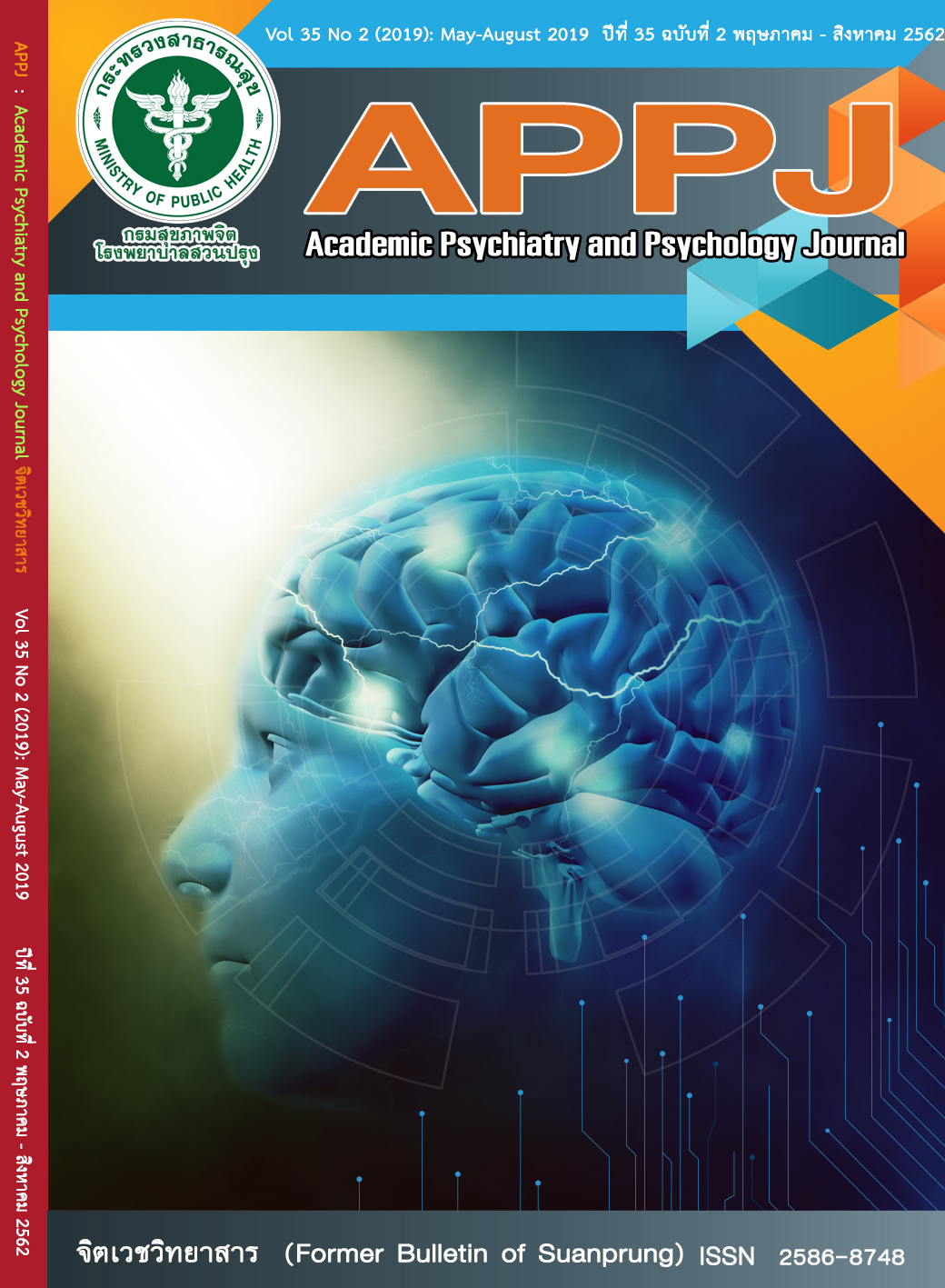The Development of Chiang Mai Amphetamine Craving Questionnaire ( CACQ)
Main Article Content
Abstract
objective: To validate CACQ for amphetamine dependent patients.
Methodology : A sample of 38 patients (with amphetamine dependence by DSM-IV criterion) admitted during August 2012 - July 2013 at Khon Kean Drug Dependence Treatment Center was used. Induced craving by cue preference was studied (5-minutes video clip of demonstrated amphetamine use) as in Cooney et al. (1997) with serum cortisol collection before and after as well as biological markers monitored. Chiang Mai Amphetamine Craving Questionnaire (CACQ) was validated by biological markers, Visual Analogue Scale of Craving (VAS) and State-trait Anxiety Inventory (STAI) before and after inducing craving by the video clip.
Statistical Analysis: Reliability of CACQ was measured with internal consistency with a Cronbach’s alpha coefficient of 0.78. Validity of CACQ was measured with: 1) Construct Validity by using correlation coefficient of CACQ and STAI, VAS : 2) Concurrent Validity by using correlation coefficient of CACQ and biological markers as well as serum cortisol : 3) Discriminant Validity by using correlation of CACQ with average change in STAI and VAS with r>0.5
Results: This study observed that cue preference induced cravings with increased VAS and CACQ score might be subjective symptoms (e.g. scores, feeling) rather than objective signs (e.g. biological markers). For CACQ: Construct Validity, CACQ had no correlation with VAS and STAI; Criterion Related Validity, CACQ seemed not correlated to biological markers as well as serum cortisol; Discriminant Validity, there was no significant finding.
Conclusion: CACQ might not be suitable for detecting amphetamine craving. This study found that craving may be a subjective symptom rather than appear as a biological marker.
Article Details
บทความหลังผ่านการปรับแก้จากกองบรรณาธิการแล้ว เป็นลิขสิทธ์ของวารสารจิตเวชวิทยาสาร โรงพยาบาลสวนปรุง กรมสุขภาพจิต กระทรวงสาธารณสุข ห้ามเผยแพร่เพื่อประโยชน์ทางการค้าโดยไม่ได้รับอนุญาต แต่อนุญาตให้เผยแพร่บทความดังกล่าวเพื่อประโยชน์ทางการศึกษาแก่ประชาชนทั่วไป ทั้งนี้กองบรรณาธิการไม่จำเป็นต้องเห็นด้วยกับบทความหรือข้อคิดเห็นใดๆ ที่ปรากฏในวารสารสวนปรุง
References
2. Fleckenstein AE, Hanson GR. Impact of psychostimulants on vesicular monoamine transporter function. Eur J Pharmacol. 2003 Oct 31;479(1-3):283-9.
3. Bhakthavatsalam P, Kamatchi GL, Ghosh MN. Tolerance pattern to amphetamine
anorexia after selective lesions in the hypothalamic dopaminergic projection. Life Sci.1985 Aug 19;37(7):635-43.
4. Wolgin DL, Hughes KM. Long-term retention of tolerance to amphetamine hypophagia following cessation of drug injections and feeding tests.Pharmacol Biochem Behav. 2001 Oct-Nov;70(2-3):367-73.
5. Gilpin NW, Koob GF. Neurobiology of alchohol dependence.Alcohol Res Health.
2008;31(3): 185-95.
6. Carter BL, Tiffany ST. Meta-analysis of cue-reactivity in addiction research. Addiction. 1999.94 Mar;94(3):327-40.
7. Tiffany ST. Cognitive concept of craving.Alcohol Res Health. 1999;23(3):215-24.
8. Childress AR, Ehrman R, McLellan AT, MacRae J, Natale M, O'Brien CP.Can induced moods trigger drug-related responses in opiate abuse patients. J Subst Abuse Treat. 1994 Jan-Feb;11(1):17-23.
9. Litt MD, Cooney NL, Kadden RM, Gaupp L. Reactivity to alcohol cues and induced moods in alcoholics. Addict Behav. 1990;15(2):137-46.
10. Kirschbaum C, Prüssner JC, Stone AA, Federenko I, Gaab J, Lintz D, et al. Persistent high cortisol responses to repeated psychological stress in a subpopulation of healthy men.Psychosom Med. 1995 Sep-Oct;57(5):468-74.
11. Kalivas PW,Volkow ND.The neural basis of addiction: a pathology of motivation and choice.Am J Psychiatry. 2005 Aug;162(8):1403-13.
12. Shalev U, Grimm JW, Shaham Y. Neurobiology of relapse to heroin and cocaine
seeking: a review.Pharmacol Rev. 2002 Mar;54(1):1-42.
13. Rawson RA, Huber A, Brethen P, Obert J, Gulati V, Shoptaw S, et al. Status of
methamphetamine users 2-5 years after outpatient treatment. J Addict Dis. 2002;
21(1):107-19.
14. Paliwal P, Hyman SM, Sinha R. Craving predicts time to cocaine relapse: further
validation of the now and brief versions of the cocaine craving questionnaire.Drug
Alcohol Depend. 2008 Mar 1;93(3):252-9.
15. Cooney NL, Litt MD, Morse PA, Bauer LO, Gaupp L. Alcohol cue reactivity, negative-mood reactivity, and relapse in treated alcoholic men. J Abnorm Psychol. 1997 May;106(2):243-50.
16. Widiger TA, Frances AJ, Pincus HA, Ross R, First MB, Davis WW, editors. DSM-IV sourcebook, vol.3. Washington, DC: American Psychiatric Association; 1997
17. Sheehan DV, Lecrubier Y, Sheehan KH, Amorim P, Janavs J, Weiller E, et al. The
Mini-International Neuropsychiatric Interview (M.I.N.I.): the development and validation of a structured diagnostic psychiatric interview for DSM-IV and ICD-10. J Clin Psychiatry. 1998;59 Suppl 20:22-33;quiz 34-57.
18. Nasreddine ZS, Chertkow H, Phillips N, et al. The Montreal Cognitive Assessment
(MoCA): a brief cognitive screening tool for detection of mild cognitive impairment.
Neurology.2004;62(5):A132.
19. Spielberger CD, Gorsuch RL. Manual for the State-Trait Anxiety Inventory STAI (form Y): Self-evaluation questionnaire. Palo Alto, CA: Consulting Psychologist Press; 1983.
20. Thapinta D. Reduction of anxiety of staff nurses working with AIDS patients through Cognitive reconstructuring and mindfulness training [Thesis Ph.D.] Bangkok: Chulalongkorn University; 1991. (in Thai)
21. Napassorn R, et al. Effective of discharge planning in amphetamine dependence
patient at Chiang Mai Drug Dependence Treatment Center. Chiang Mai: Research
Report of Chiang Mai Drug Dependence Treatment Center; 2011. (in Thai)

